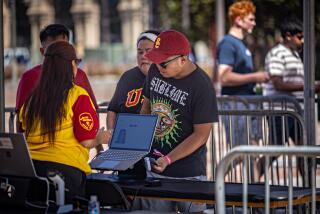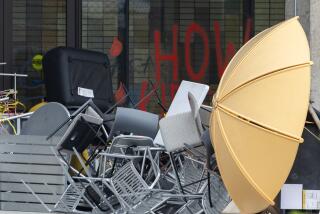Quake-Ravaged CSUN Reopens Amid Confusion
- Share via
Cal State Northridge’s portable university began its spring semester Monday, two weeks late and plagued by unusable temporary classrooms and confusion as 15,000 students struggled to find their way on the earthquake-racked campus.
Students and teachers found two of the 198 temporary buildings had burned down and many others were dark and missing furniture as the university tried to rebound from the magnitude 6.8 earthquake that caused an estimated $350 million in damage to the campus. It was believed to be the most devastating natural disaster ever to strike an American college.
While there were many problems linking students up with classrooms in the unlikeliest locations--”Political science, your class is meeting in front of a blue Dumpster,” a campus police officer shouted over a bullhorn--a number of state and local officials showed up to celebrate the achievement of reopening the campus at all.
Speaking by phone to a rally attended by more than 100 students and campus officials, President Clinton praised the Cal State Northridge staff for getting the school back on its feet.
“I can’t believe . . . you’re back open a month later. It’s a real tribute to you. I’m glad to hear the California spirit is alive and well,” Clinton said to the cheers of students during a 15-minute phone interview on the Michael Jackson talk show on KABC radio.
Los Angeles Mayor Richard Riordan appeared in a CSUN T-shirt emblazoned with the campus’ post-earthquake motto--”Not Just Back . . . Better”--a slogan that was challenged by an unforgiving reality Monday.
Credited, and occasionally denounced, for the quick reopening was Cal State Northridge President Blenda J. Wilson, who made the decision shortly after the Jan. 17 quake to remake CSUN as a university in a box--or clusters of boxes. The school’s revival “has been the most extraordinary experience of my life,” she told the crowd.
In a brief reference to the chaos surrounding her, Wilson said, “Clearly, it will take us a couple days to get the bugs out of this new place.”
The semester was supposed to have begun Jan. 31 but the Northridge quake two weeks earlier put all nine primary classroom buildings out of commission. Of the 53 major campus buildings, fewer than 15 were in use Monday morning. Among the most hard-hit was the Oviatt Library, the largest building on campus. Students who need to do research will be taken by bus to UCLA, an hour’s shuttle ride away.
To make up for lost course time, the spring break will be eliminated and the semester will be extended a week.
While there was much confusion and difficulty in getting the students together with their instructors--many teachers did little beyond promising their students that next time it would be better--some students seemed to take the problems in relatively good humor.
“It’s a comical situation,” said Scott Mason Jr., 34, a business major who arrived for his 7 a.m. finance class to find that his modular classroom had no desks, chairs, electrical power or heat. There were no stairs so students had to climb in through a door three feet off the ground, and there was no sign identifying the building.
Others were not so lighthearted.
Daniel Taub, 20, of North Hills, arrived an hour before his 9 a.m. class to begin hunting for classroom 1326. Trying to follow a map, he went in one direction, then in another, looking for his class in the maze of portable buildings set up in athletic fields and elsewhere.
After asking directions twice, he finally arrived, out of breath and just in time to answer “Here!” when his name was called.
“This is . . . hell!” another lost student shouted out. While the students and teachers wandered around amid the clusters of buildings, workers continued installing electrical wiring.
Adding to the anxiety was a magnitude 3.3 aftershock, which rolled through the campus at 12:32 p.m.
Kathleen Neumeyer, Taub’s teacher, shouted over the roar of a generator that she would be teaching concepts for the first three weeks because no writing could be done.
“Welcome to a new adventure,” she said. “This is the computer center, but we don’t have computers. We don’t know when we will get computers, or if we will get computers at all this semester.”
Tom Ho, a 22-year-old business major, waited three hours for his 7 a.m. class. Finally, at 10 a.m., a man in a hard hat kicked him out of the trailer.
“I got up at 6 a.m. to get here and stood around for three hours. They should have waited until they set up everything before they tell us to come back,” he said.
One much-anticipated problem, that traffic and parking would be a nightmare because of the collapse of the largest parking structure on campus, failed to materialize. Streets in surrounding neighborhoods that are usually closed to parking were opened up.
Some people had to wait as long as 30 minutes for a spot, but a shuttle system set up by the university appeared to work well bringing students to campus from outlying parking areas.
Once students made it to the 353-acre campus, attendants at 22 information booths gave them directions. More than 24,500 students, about 1,500 fewer than last spring, were signed up for classes.
The classroom situation turned out to be much worse than anticipated. As late as Sunday, university officials were assuring people that all portables would be in place Monday morning. But the rooms were still arriving Monday.
Also, many of the temporary buildings already on campus were not ready for occupancy. Officials estimated that 120 classrooms, about a third of the total, were out of service Monday.
Wilson said she did not regret pushing the deadline. If it had not been for the rain and then the high winds in recent weeks all the portables would have been in place, she said.
Two of the portables burned down Sunday morning. Rolando Canche, 19, discovered this when he went looking for his Chicano studies class and instead found his professor, Alberto Garcia, holding class in an open field. Fire officials have labeled the blaze suspicious.
Of the general disarray Monday, the university’s chief spokesman, Bruce Erickson, said jokingly, “Problems? What problems? It looks like the typical first day after an earthquake to me.”
Then Erickson added, “It could have been much more chaotic than it is. It was a gamble. It was not a foregone conclusion that we were going to be able to open.”
Dust from construction blew into the faces of students waiting more than two hours in a long line at the Student Union--converted into temporary administration offices--for their financial aid checks. More than $8 million in financial aid had been trapped in the damaged administration building.
“It has been exhilarating,” said Freddy Brown, a six-year staff member in the student aid business office. “These kids out here--few of them have been impatient considering the circumstances they have been going through--they are great sports.”
The plan to reopen Cal State Northridge in temporary quarters was put into action Jan. 27, when Wilson gave the go-ahead to bring in hundreds of portable buildings from as far away as Northern California and Nevada. Construction teams worked around the clock anchoring the buildings in place and Gov. Pete Wilson waived state regulations so that the extra-wide portable buildings could be hauled at night to make the deadline for the reopening.
There were those, however, who felt the deadline should have been extended.
When Sharon Eisenberg, a 20-year-old junior majoring in communications studies, began her search for her 8 a.m. psychology class, she was in good spirits. But that mood wore away, along with the soles of her shoes.
“Boy, I’m really late for my class and I might be dropped. I’m really nervous,” she groused to one of the campus guides, who was unable to help her.
That was enough.
“This school is insane. You can quote me on that. I should have transferred to San Diego State when I had a chance.”
Times staff writers Chau Lam, Teresa Ann Willis and John Schwada contributed to this story.
More to Read
Sign up for Essential California
The most important California stories and recommendations in your inbox every morning.
You may occasionally receive promotional content from the Los Angeles Times.













